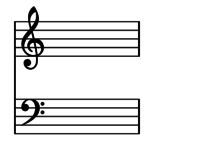Music Theory/Fundamentals of Common Practice Music
< Music TheoryNotation
This section is intended for those without any experience with Western music notation and associated practices.
Humans with the ability to hear, experience sound when delicate structures inside their ears detect waves of pressure traveling through the air (or any other medium to which they are mechanically coupled). When these waves are regular, and arrive at intervals that fall within a certain range, we recognize a tone, or note. Notes are the basic elements of Western music.
Pitch
When the waves causing a note are close together, and so cause more vibrations per second in our ears, we say that tones have a higher frequency or pitch. Pitch is measured in Hertz (Hz). When the waves are further apart we say they have a lower frequency or pitch. When we hear series of higher and lower notes either singly or in groups, themselves spaced out at different points in time and of different durations, and the variation in their frequencies, spacing, and lengths are patterned in ways that correspond to established rules, we recognize the sound as music.
Writing and Analysis
Written music is presented on one or more staves, which represent a set of notes that may be played in time across one or more instruments. Most contemporary music will consist of a pair of staves, as per this example, showing treble and bass clefs. Staves are divided into regular periods of time, known as bars. The duration of a bar in a given piece of music is specified with a time signature, which is shown next to the clef. Contemporary music often uses 4/4 and 3/4 time signatures.

Sometimes, music written for fretted instruments such as guitars will be presented as a tablature rather than standard musical notation on a staff. A tablature is a more direct way of showing how the instrument should be played, listing finger positions rather than notes. Keyboarded instruments such as the piano offer a simple translation from musical notes to finger positions, while stringed or valved instruments require the player to be able to translate notes into positions along strings, or specific valves that must be opened.